Reading time : 12 minutes
The Viking world was full of symbols, many of which have become very popular symbols for Viking tattoos (I may have one or two).
The historical evidence for how the Vikings used many of their symbols is based on putting together disparate puzzle pieces and making assumptions based on what we know of Norse mythology and Viking culture. So not everything we know about Viking symbols is concrete and there is plenty of room for debate. But this is part of what makes them so interesting.
Below we’ll share our take on some of the most important symbols associated with the Vikings, many of which appear on ancient jewelry pieces, and modern jewelry pieces that you will find in the VKNG store.
1. Mjolnir, Thor’s Hammer
It is difficult to talk about a Viking symbol without mentioning Thor’s hammer, known to the Vikings as Mjolnir.
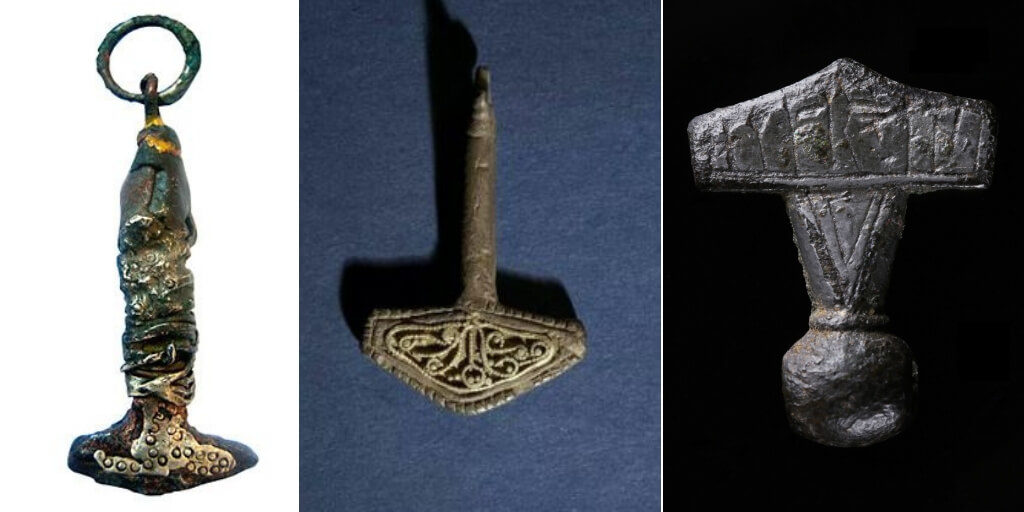
The hammer was made by dwarven craftsmen at the request of Loki to help him appease Thor after he cut off all of his wife Siff’s hair in a prank. Loki’s machinations meant that the hammer had a very short handle and could only be wielded by someone of enormous strength, such as Thor.
The Vikings wore the hammer as a symbol of protection, as Thor protected Midgard and Asgard from the chaotic forces of the giants with Mjolnir.
It was the most popular symbol used in the Viking age and more than twice as many Mjolnir symbol pendants survive in the archaeological record than all other symbols combined.
It was also one of the few symbols that continued to be used well into the Christian period, worn by those who continued to follow the old religion and venerate the old gods.

Symbols linked to Thor’s Hammer
When Loki procured Thor’s hammer from the dwarves, he also procured a number of other treasures that became important symbols in the Viking world.
The story goes that, as a joke, Loki snuck into the home of Thor and his wife Siff one night and removed all of Siff’s beautiful golden hair, at the root so that it would never grow back.
When Thor awoke and discovered his distraught wife, he knew that Loki was responsible. He threatened to do worse than kill Loki if he did not replace it with something as fine as her original hair.

Loki knew that the only place to procure such a thing was from the dwarves, the master craftsmen of the Norse world. He asked the dwarven craftsmen known as the Ivaldi brothers to make a golden headpiece for Siff and enchant it to grow on her head.
He also convinced them to make two further treasures for the gods as a gift. these were a magical boat called Skidbladnir that always caught a good wind, but while it was big enough to carry all the gods and their steeds, it could fold down like a piece of paper until it resembled a thin piece of wood to be carried across the land. Loki would eventually give this treasure to the god Freyr.
They also made Gungnir, a spear so fine that it would never miss its mark, even if the warrior was not very skilled. Loki would eventually give this gift to Odin, and it would become a symbol most commonly associated with the god of war. It is worth noting that it was the spear and not the sword that was the weapons most Vikings carried into battle.
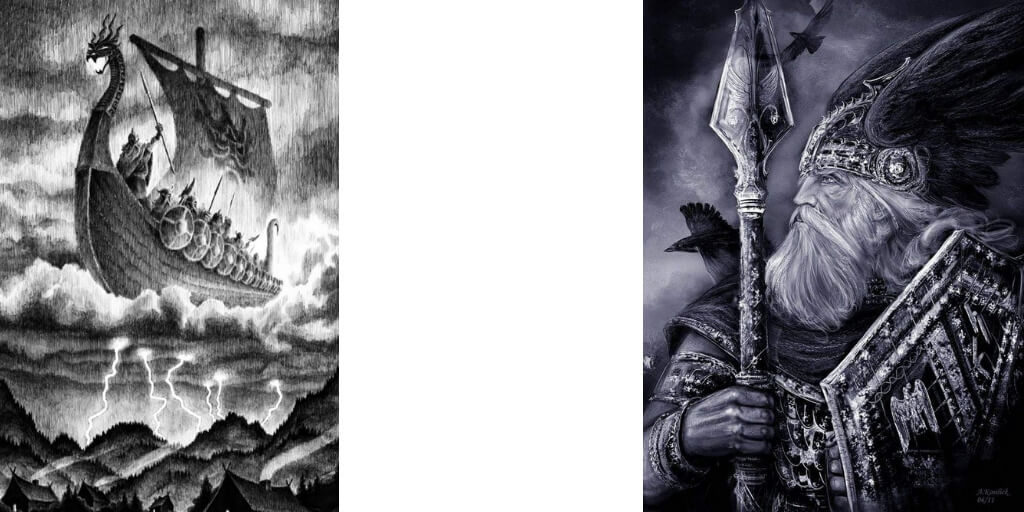
While waiting for the treasures to be made, Loki couldn’t help but get into a bit of trouble. He approached two other dwarven craftsmen Brokkr and Sindri. He told them of the fine treasures that the Ivaldi were making for the gods and that no other craftsmen could make something to equal them.
Naturally, Brokkr and Sindri took this as a challenge and were tricked into making a bet with Loki that they could make finer treasures. They too would make three fin treasures for the gods, and all of them would be taken to Asgard for the gods to judge which were the best. However, rightly suspicious of Loki, they demanded that if he lose the bet, he would owe them his head.
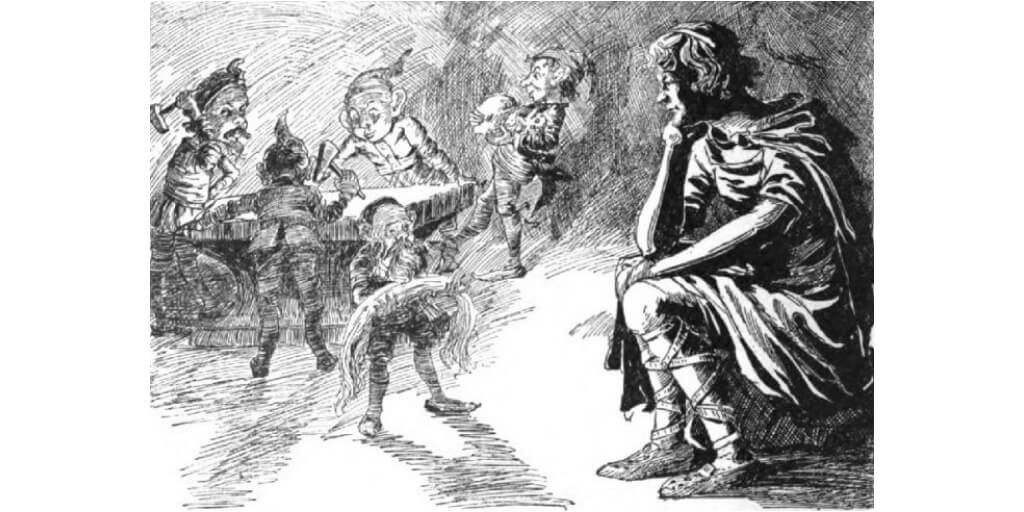
Brokkr and Sindri made three other fine treasures. First, they made Gullinbursti, a living golden boar that was capable of running faster than any horse over land, sea, and air. Its golden hair illuminated the darkness. This treasure was given to Freyr and became one of his identifying symbols.
Next, they made Draupnir, a golden ring of the highest quality and beauty. It was also enchanted so that it would create eight new rings of equal quality every nine days. Loki would give this ring to Odin.
The final and best treasure that they made was Mjolnir, the hammer that Loki would give to Thor.
But keen not to lose the bet, Loki tried to sabotage the work of the two dwarves. He turned himself into a fly and tried to sting and bite the pair to distract them from their work. While he failed the first two times, he did succeed in distracting one of the brothers for a few seconds while they were making Mjolnir, and this is why it came out with a handle that was shorter than intended.
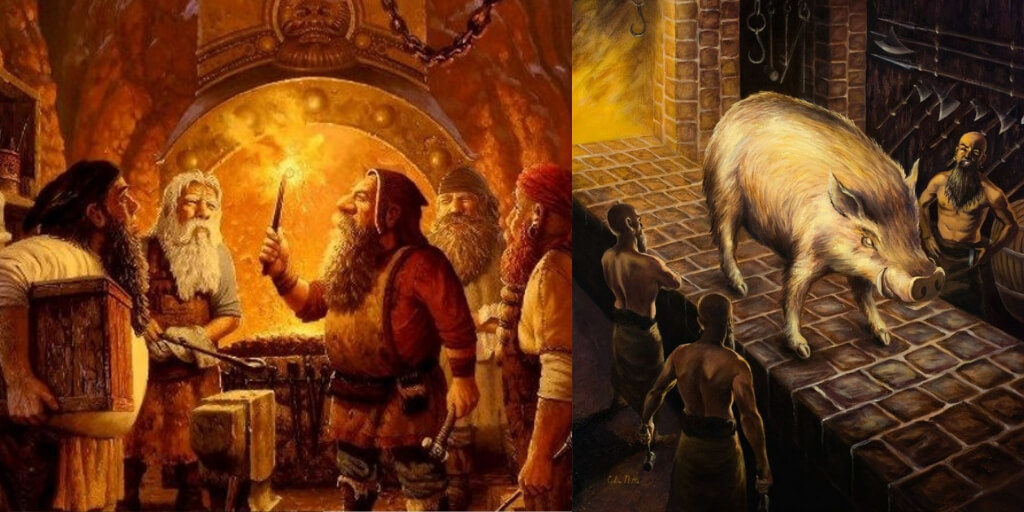
While Loki tried to escape to Asgard with all six treasures and leave the dwarves behind, they tracked him there to be present for the judgment of the gods. While they were very impressed by all the treasures and received them gratefully, they unanimously agreed that Mjolnir was the finest thing that they had seen and that it was the best of all the treasures.
Prise Edda on Thor’s Hammer:
“Then he gave the hammer to Thor, and said that Thor might smite as hard as he desired, whatsoever might be before him, and the hammer would not fail; and if he threw it at anything, it would never miss, and never fly so far as not to return to his hand; and if be desired, he might keep it in his sark, it was so small; but indeed it was a flaw in the hammer that the fore-haft (handle) was somewhat short.”
Brokkr and Sindri, having won the best, demanded Loki’s head. He evaded them saying that he promised his head and not his neck and that they could not take one without the other. They turned to the gods for justice, and they said that they could sow Loki’s mouth shut, which they did. However, this seems to have been temporary, as it was not long before Loki was back to his old tricks.
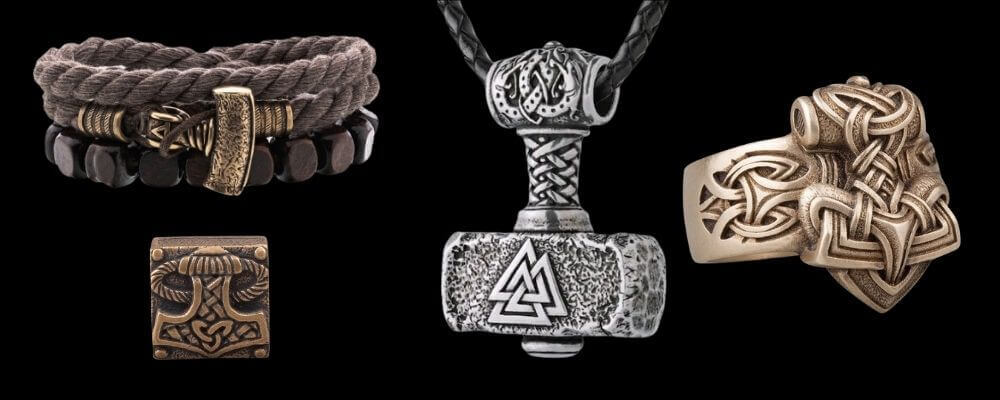
The Valknut
The Valknut, a symbol of three interlocking triangles, is one of the most commonly appearing symbols in the Viking world. It always appears in combination with Odin or the dead, which has led many to believe that it was a symbol of Valhalla.
Valhalla is Odin’s hall in Asgard. He chooses the bravest fallen warriors to dwell there. There they live in paradise until they are called on again to fight alongside the gods in the final battle of Ragnarok. It is the aspiration of all warriors to reach Ragnarok.
The Valknut symbol may have been used to indicate that the fallen warrior was now in Valhalla. It may also have been used to call the Valkyries, the helpers of Odin, to take his soul to Valhalla, or to ward off spirits that might want to take the would of the warrior to one of the other Norse underworlds.

The Valknut is made up of three triangles, creating nine points. The number 9 is a very important number in Viking culture, especially because it is associated with the nine worlds of Norse mythology.
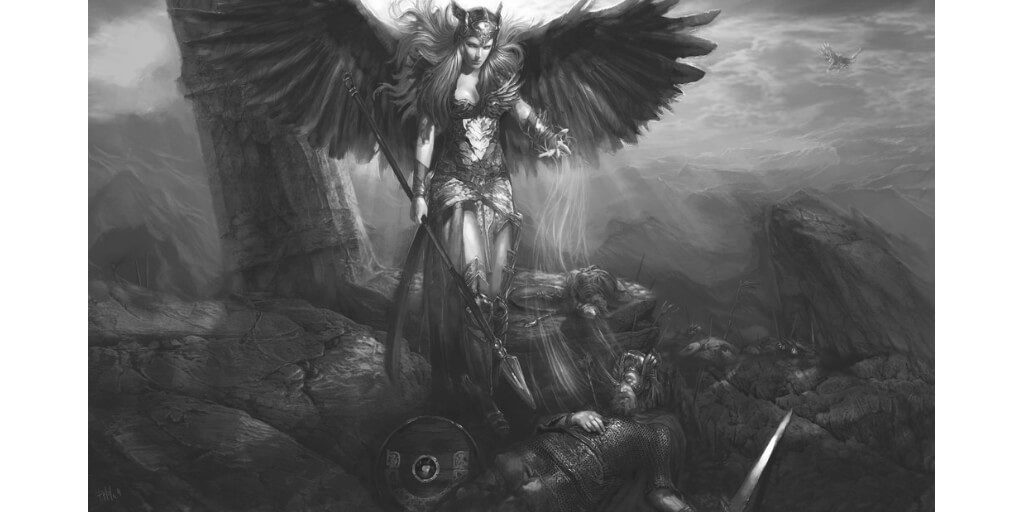
The Valknut features on the Stora Hammar stone of Lärbro in Gotland in Sweden. Several Nordic symbols are engraved and colored on the stone.
The scene shows Odin descending to recover a warrior fallen in battle. Odin is identified by his spear Gungnir and raven families. Odin’s hands form a sign of blessing, lifting the warrior’s body from his grave to Valhalla. The Valknut is represented in the sky.
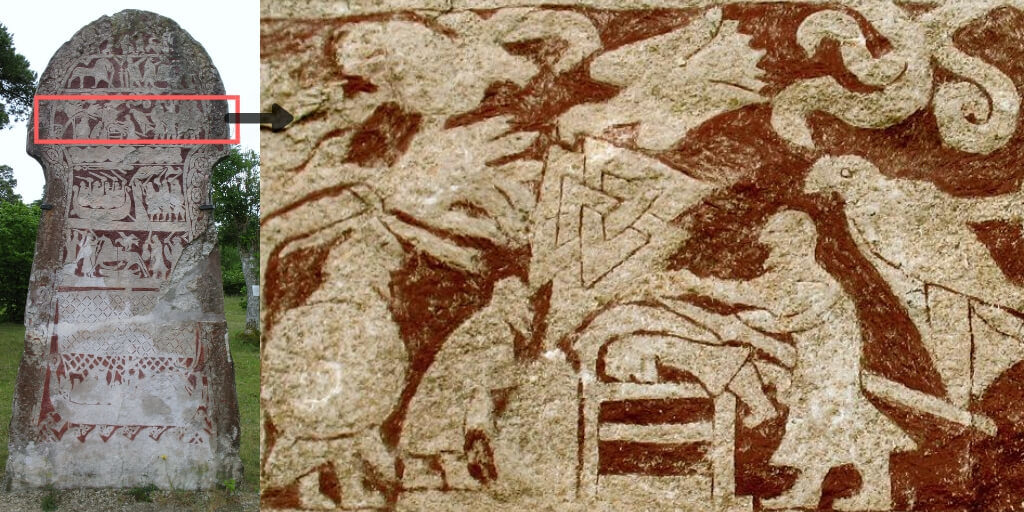
The Tängelgarda stone from Gotland also features the Valknut. The symbol appears between the legs of the warrior’s horse. The warrior is thought to be Odin, perhaps leading the warriors behind him to Valhalla.
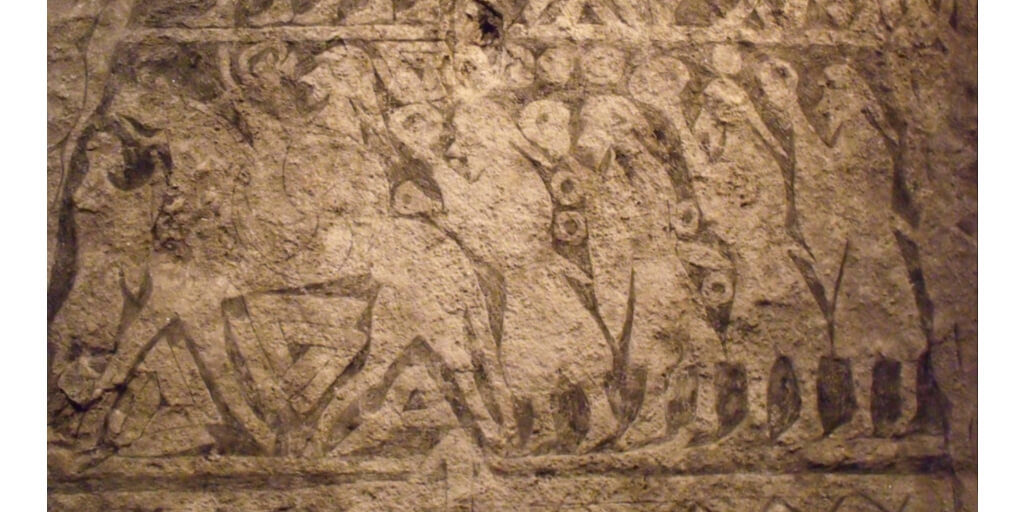
This ring represents late Anglo-Saxon art and does not have the characteristics of a ring forged by the Vikings. The Vikings only very very rarely used gold for their ornaments, they prefer silver.
The Valknut also appears on a gold ring found in England, near Peterborough, discovered in 1855 in the Nene River. This ring is very special, it is composed of two discs placed opposite each other around the circle. On each side of the discs, there are clusters of three granules.
From the end of the 8th century onwards, it is not uncommon to find the artistic influence of Scandinavian immigrants in the creation of rings, brooches, and other jewelry from Great Britain. But then why did they choose to use the Valknut symbol for this ring?
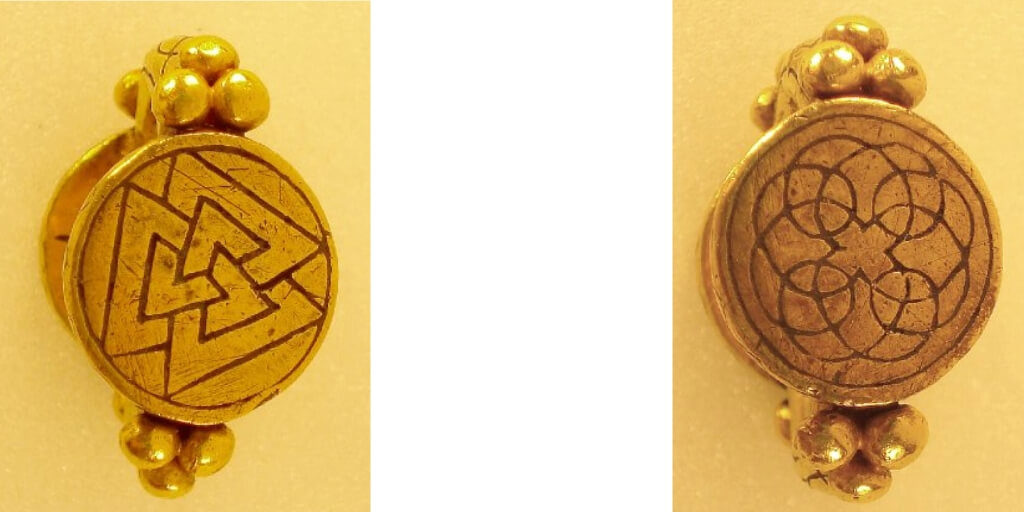

There are many other relics that use the Valknut symbol. There appears in the famous Oseburg ship burial engraved on the base of the ship. It appears on a 10th-century tombstone from Yorkshire, while it was under Viking control. The Valknut appears on various urns from East Anglia, alongside wolves and ravens, other symbols of Odin.
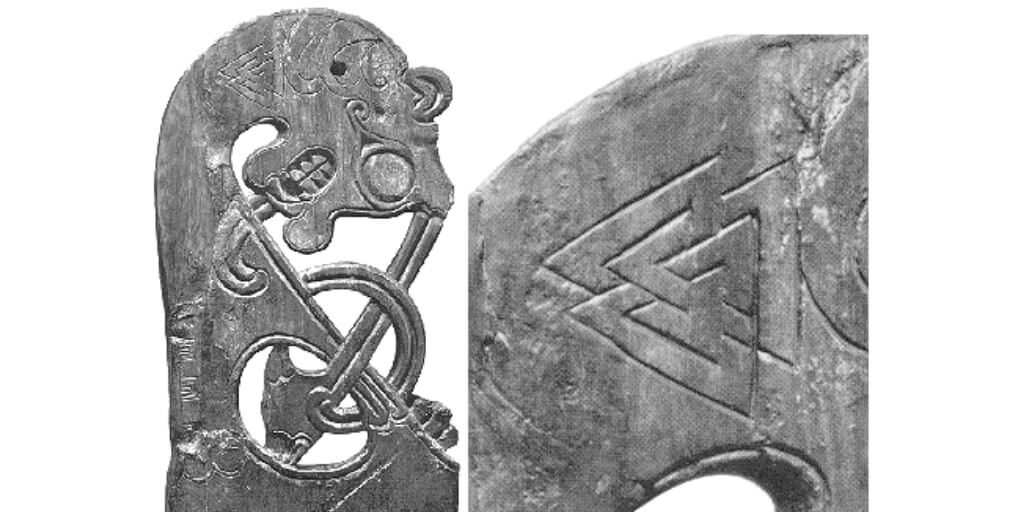
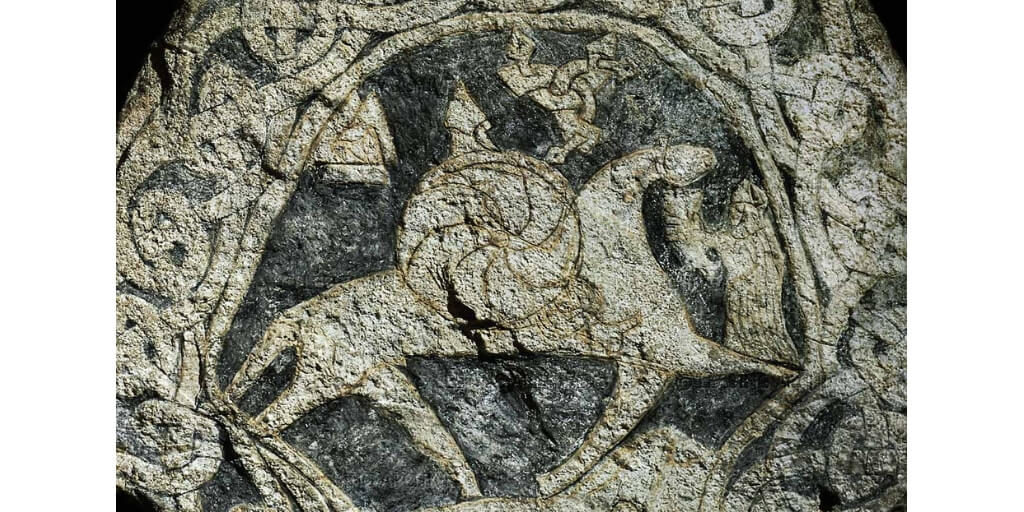
3. Aegishjalmur / Helm of Awe
The Vikings used a runic alphabet, but for them, the runes could do more than just describe the world. In the hands of a runemaster, they could be used to shape the world through magic.
The Norns, the Norse fates, write the destiny of men into the bark of the world tree Yggdrasil using the runes. Odin hung himself from Yggdrasil for nine days and nine nights while pierced by his own spear to learn the secrets of the runes. He then shared these with making.
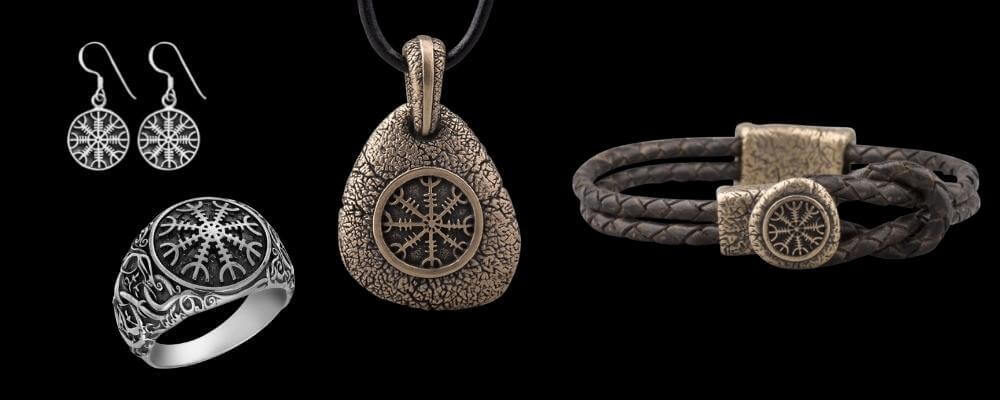
We do not know much about how the Vikings themselves used the runes, though there are many references to the use of rune magic. But we know how runes were used in later Scandinavian culture thanks to a group of magical Grimoires dating from 18th century Iceland.
The most famous symbol in these grimoires is Aegishjalmr, more commonly known as the Helm of Awe. It was a symbol of protection. According to the grimoire, warriors can draw the symbol on their forehead to invoke the favor of the gods and ensure their bravery and success in battle.
It is composed of 8 branches resembling radiant tridents around a central point. The central point can represent the thing to be protected, the tridents being the offensive means of this protection.
If we look at the etymology, “aegis” means “shield” and “hjalmr” corresponds to the word “helmet” in Old Norse.
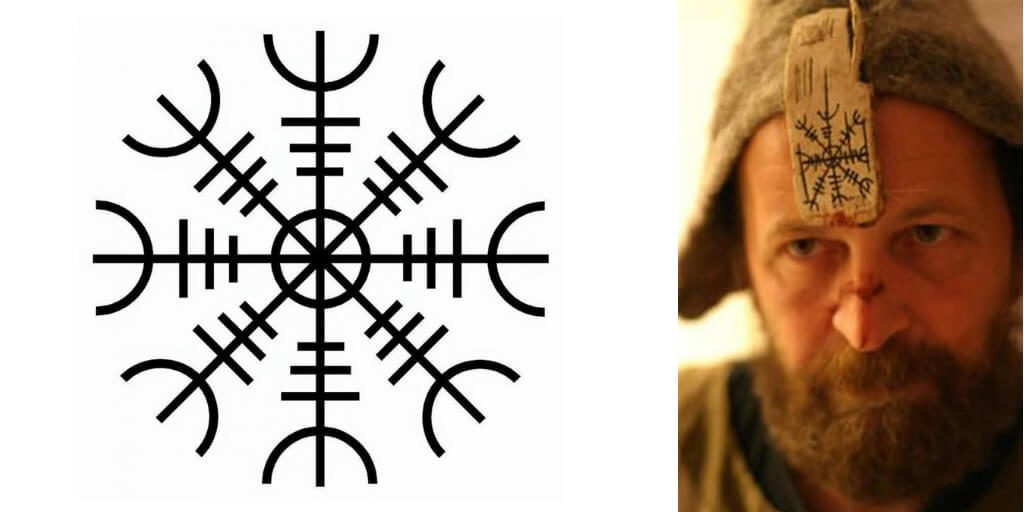
milli brúna mér!
between my brows!
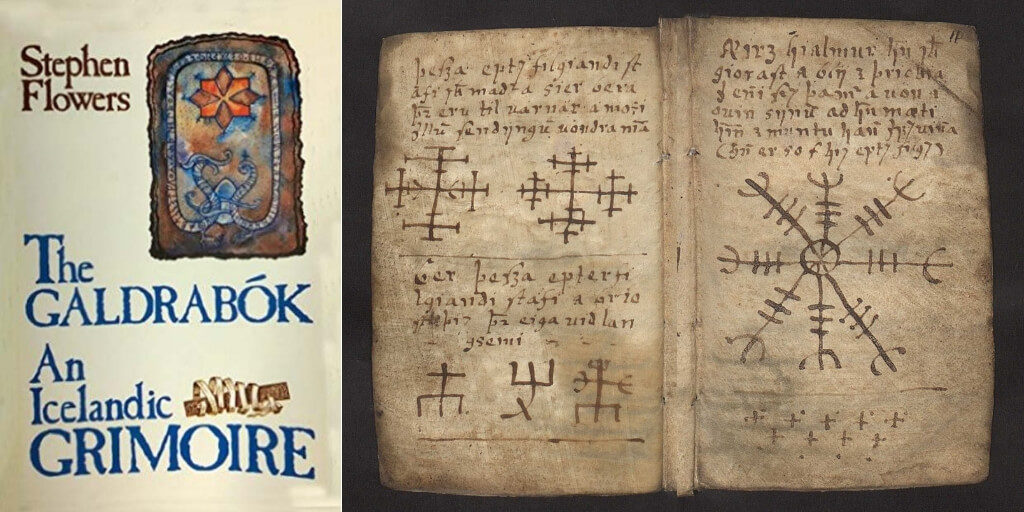
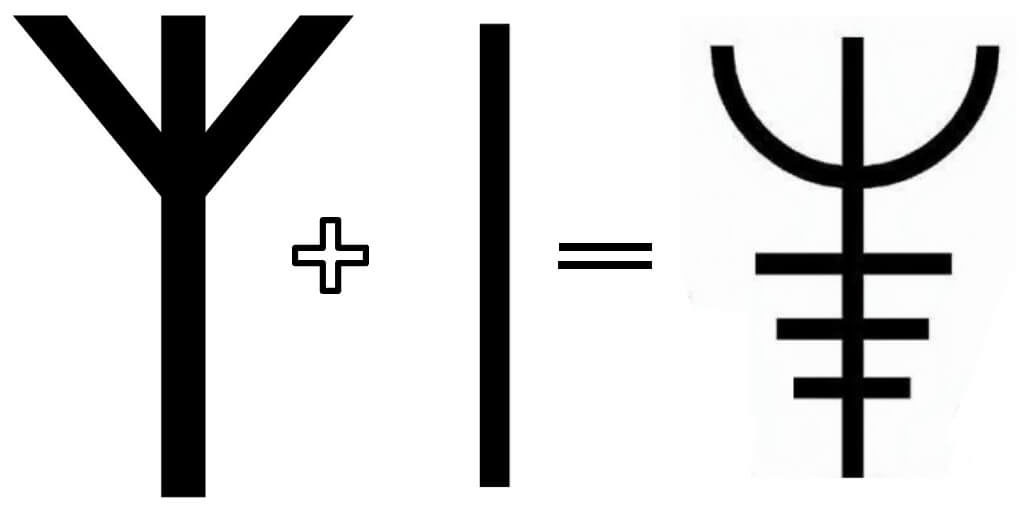
While no examples of the Aegishjalmur symbol survive from the Viking world, it is mentioned in a number of Viking texts. For example, in the Fáfnismál, the dwarf turned dragon Fafnir boasts of using the Ægishjálmur, making it invincible.
“The Helm of Awe
I wore before the sons of men
In defense of my treasure;
Amongst all, I alone was strong,
I thought to myself,
For I found no power a match for my own”
4. Vegvisir / Norse Compass
This symbol is frequently confused with Aegishjalmur, as Vegvisir (pronunciation Vegg-Vee-Seer) also has 8 branches but each is different from the other. It is also a symbol that is found in the Icelandic grimoires, and while we would like to think that it was used in Viking times, no examples survive.
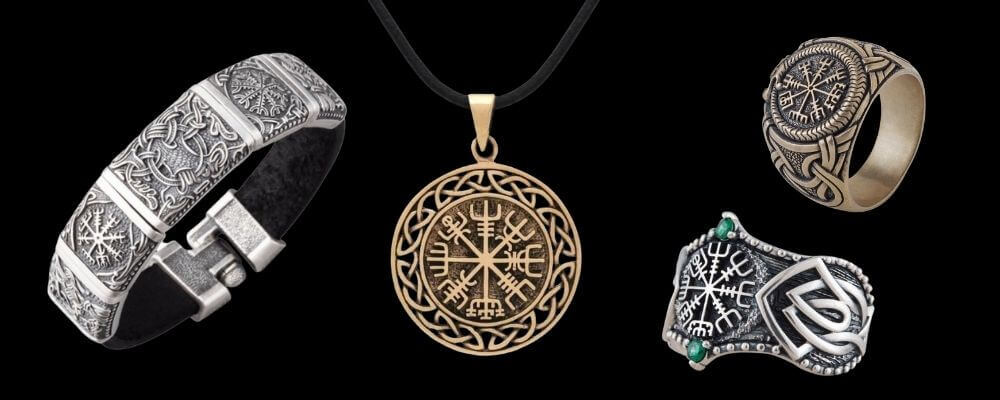
It was a wayfinding symbol, and according to the grimoire, the user will never lose their way, even if they do not know where they are going. While this was probably designed for physical navigation – the Vikings often took to the high seas with very few navigational tools – in modern Asatru the symbol has also become associated with spiritual guidance.

Vegvisir is mentioned in two different grimoires. The first is the Galdrabok, ostensibly dating to 1600, it contains 47 spells. It was first published in 1921, it says that the symbol ensures that we never get lost and always find our way home.
It also appears in the Huld Manuscript, which dates to 1860. Written by Geir Vigfussen, it gathers and analyses many symbols and spells. Concerning the Norse Compass, it says the following.
“If this sign is carried, one will never lose one’s way in storms or bad weather, even when the way is not known.”
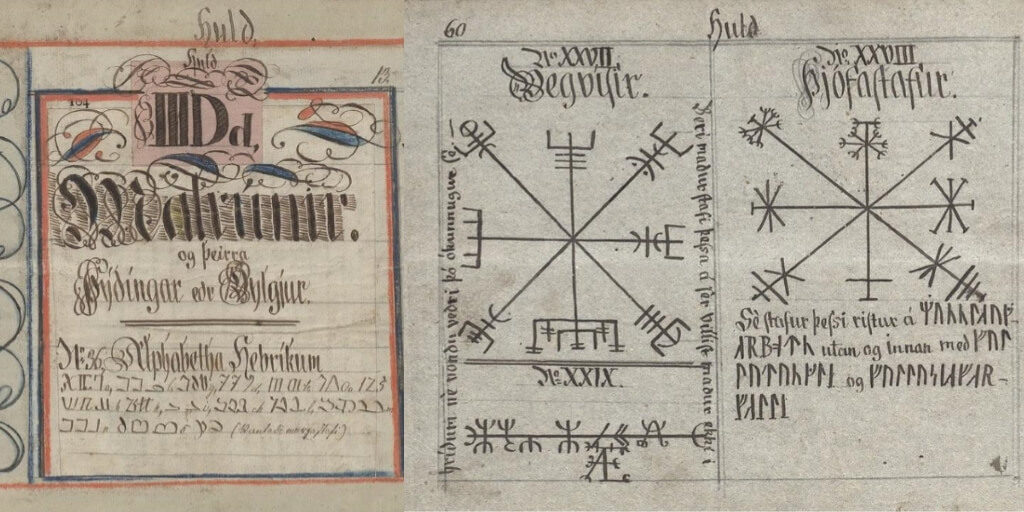
5. Yggdrasil / World Tree
Yggdrasil means “horse of Odin” or “horse of yggr”. “Ygg” means “the fearsome” and is one of the many names given for Odin in the Gylfaginning. “Drasill” means “horse”.
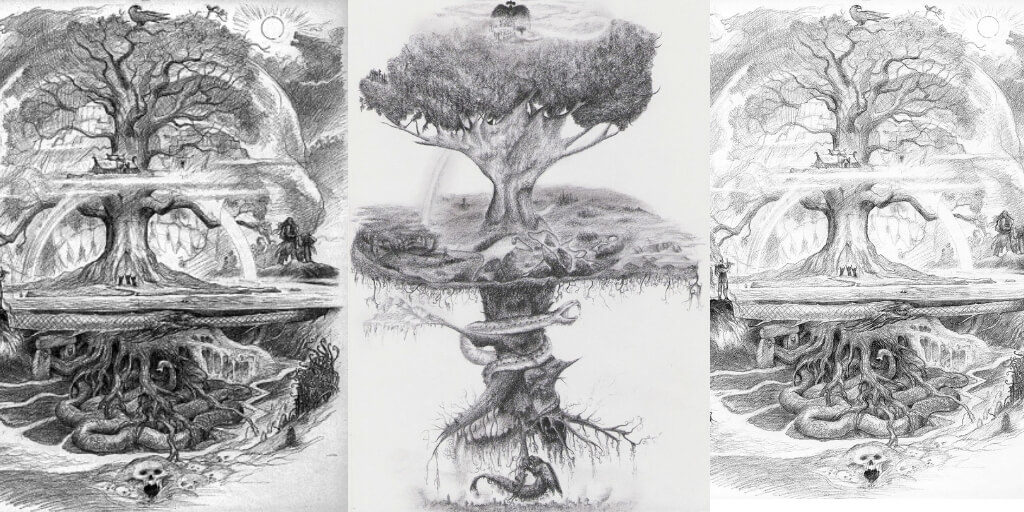
Yggdrasil or Yggdrasill is presented as an evergreen ash tree, the largest and most perfect of all trees. Its branches cover and integrate into heaven and earth. This Norse symbol is the cosmic tree, the tree of life, the center of the world.
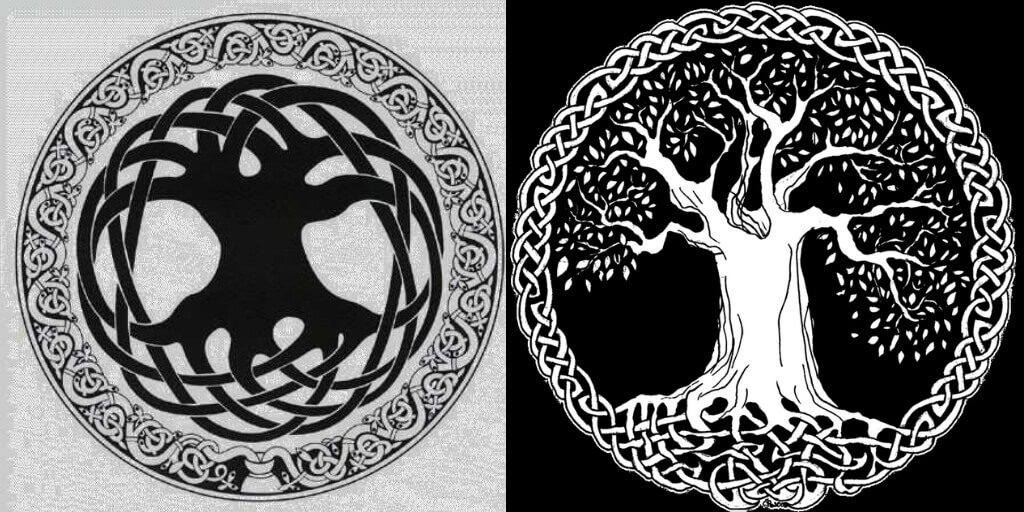
Yggdrasil symbolizes the life of everything, it is not only one of the most important symbols of Viking and Scandinavian culture but also the founding element of the Nordic faith itself.
It is the pillar axis of the Nordic cosmogony (system of formation of the universe).
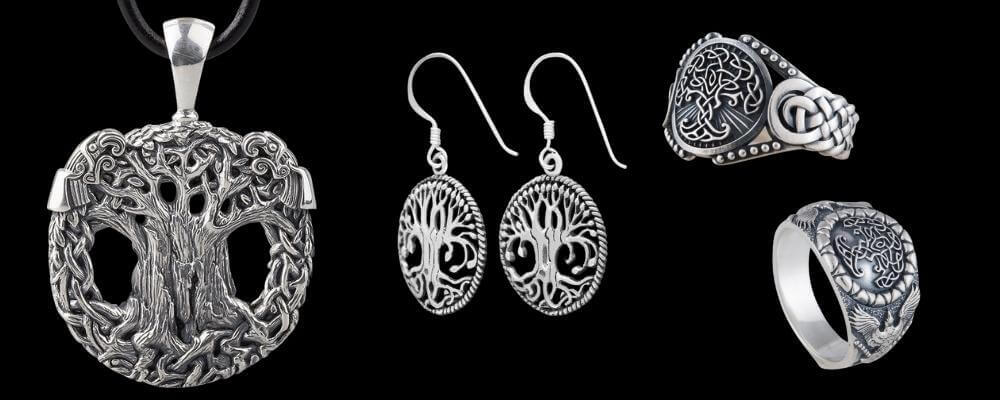
The Vikings believed that the nine worlds of the Norse cosmos were tucked into the roots and branches of the tree. The tree connects the world and passes life-giving water between the worlds. But the tree also separates the worlds and maintains order within the universe.
What are the nine worlds of Norse mythology? You can read a detailed description of the Norse cosmos here.
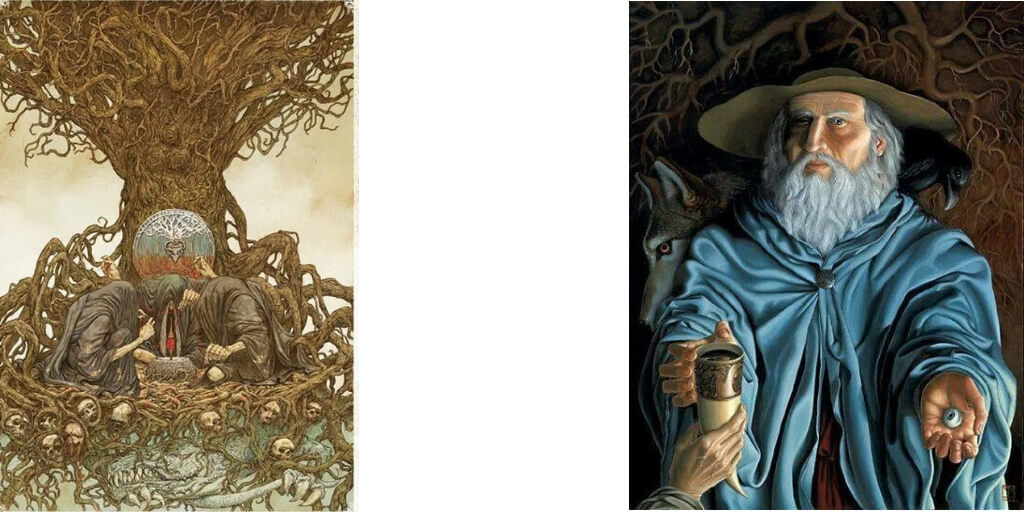
Svefnthorn
Svefnthorn – ‘sleep horn’ in Old Norse – was a spell that the Vikings used to place someone into a deep sleep.
The symbol used to represent the spell varies from source to source, and it is unclear if the symbol played a physical role in the spell, or simply represented it. The image below is a modern representation that is not found in the Viking world.
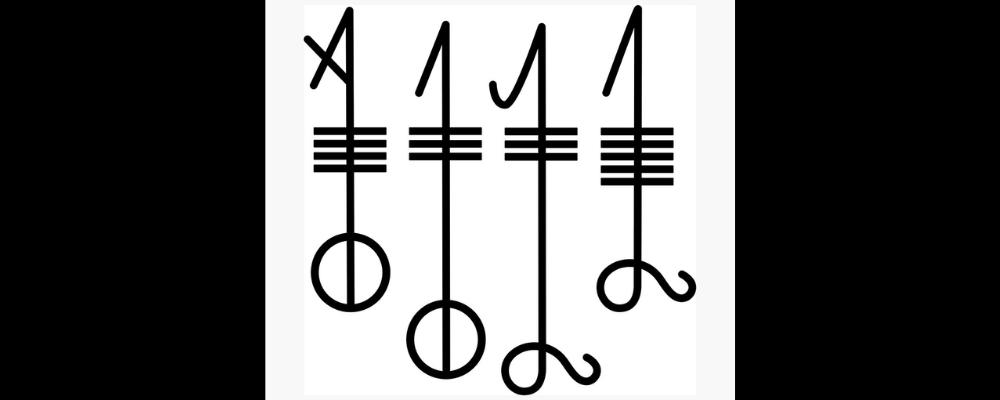
This variation may have indicated variations in the application of the spell, which sometimes seems to have been used in jest, and at other times to disable serious adversaries.
Odin, the master spellcaster, uses Svefnthorn to place the Valkyrie Brynhildr into a deep slumber from which she can only be awoken when a hero crosses a formidable circle of fire that Odin has created around her.
Queen Olof ‘sticks’ King Helgi with a Svefnthorn in order to render him unconscious for just a few hours so that she can play a trick on him and his men.
Valhjalmr similarly ‘stuck’ Hrolf with a Svefnthorn, which seems to have been a physical thing, as Hrolf only awakens when it is shaken loose by a horse.
One old Icelandic spell book advises the user to carve the symbol into a piece of oak and place it under the person’s bed.
Meanwhile, another spell makes no mention of the symbol and instead describes the spell as using a dog’s heart that has been placed somewhere that the sun does not shine for thirteen days.
Gungnir
Gungnir, the spear of Odin, was obtained for Odin from the forges of the dwarves. Since Odin was the god of war, it makes sense that a spear would be his symbol as almost all Viking warriors carried on into battle. Swords were expensive and difficult to make and only the wealthiest warriors carried them. Odin is almost always depicted in contemporary works with the spear in hand.

The war between the Aesir and Vanir gods of Norse mythology is described as officially starting when Odin throws his spear over the assembled Vanir gods.
In honor of this, the Vikings too would often throw their spears over the heads of their enemies to signal the start of the battle.
When the Vikings made human sacrifices to Odin, they would also do this with a spear, just as Odin stabbed himself with Gungnir in order to gain knowledge of the runes.
Gungnir is described as being so well balanced that it could strike any target, regardless of the skill of the thrower. It also seems to have magic runes carved in its tip, the purpose of which is never specifically revealed.
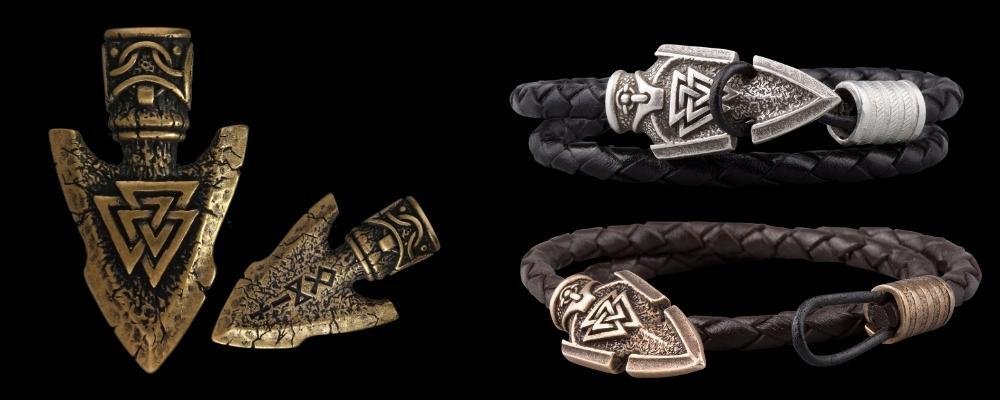
The spear seems to have been associated with the military might of the Vikings, which will only fail at the end of days.
Odin is portrayed as using the spear to engage with Fenrir during the battle of Ragnarok. At this moment it is prophesied that the spear will finally fail Odin, and he will fall to Fenrir.
The death of Odin is the beginning of the end as the Aesir gods are wiped out and the nine worlds of Norse mythology destroyed.
Swastika
While the Swastika has taken on a very different meaning today, among the Vikings, it represented prosperity, power, and protection.
This is because among the Vikings the Swastika [and also the Sun Wheel] was used to represent Thor’s Hammer, Mjolnir.
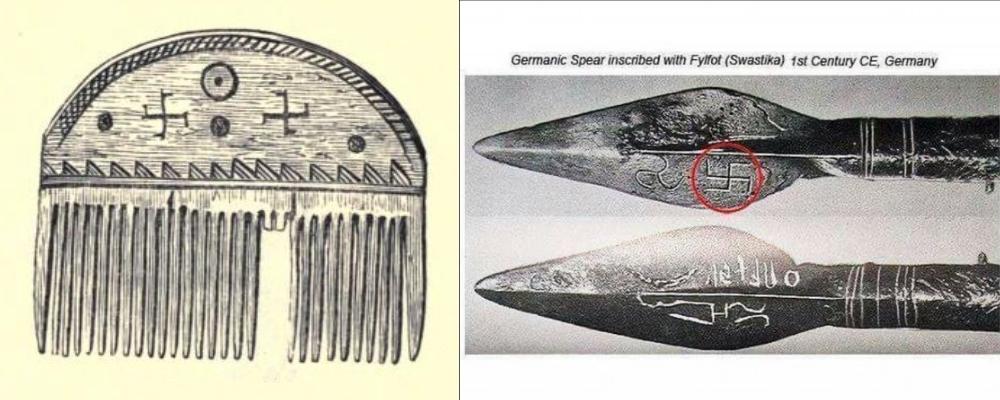
The Swastika often appears alongside representations of Thor’s Hammer, or used interchangeably with the symbol for Mjolnir. The Swastika has also been found carved into many Viking Age hammers.

For the Vikings, Mjolnir, and therefore the Swastika, represented power and protection, as Thor was the protector of both Asgard, the realm of the Aesir gods, and Midgard, the world of men, and used his hammer to defend them against the chaotic forces of the giants.
These symbols also represented the sun and sky, as Thor was the main sky god in Norse mythology.
As well as representing force and strength, Mjolnir also protected the Vikings by representing order.
Mjolnir was used to hallow important events, such as births and marriages, which reinforced the social order that protected communities. Thus Mjolnir, and in turn, the Swastika, were symbols of order and safety, whether achieved by force or community consensus.
Web of Wyrd
The Vikings believed in fate.
The fact that even the gods had a prophesied fate that they could not escape, in the form of the Ragnarok apocalypse, reflects the power that the Vikings gave to the idea of fate.

The Norse symbol is known today as the Web of Wyrd and represents the matrix of fates, as crafted by the Norns, who controlled the fate of everything in the Norse cosmos.
The symbol was made up of nine interlocking staves, nine being a sacred number among the Vikings: there were nine worlds, and Odin hung off Yggdrasil for nine days to learn the secrets of the runes.
The way that the staves interlocked represented the inextricable connection between past, present, and future, and how one influences and flows into the next.
It was a reminder to the Vikings that where they are today is a result of their past actions, and that their present actions will shape the future.
Troll Cross
In Sweden and Norway the Troll Cross, or trollkors, is a bent piece of iron worn as an amulet to ward off malevolent magic.
The symbol seems to have fairly modern origins, created by a Swedish smith in the late 1990s, which she claims she copied from a protective rune that she found on her parent’s farm.
The symbol does bear a resemblance to the Othala rune used in Elder Futhark, but which is not part of the Younger Futhark commonly used by the Vikings.
It seems to have been linked with ideas of heritage and inheritance and may have been linked with ideas of calling on the protection and help of ancestors.
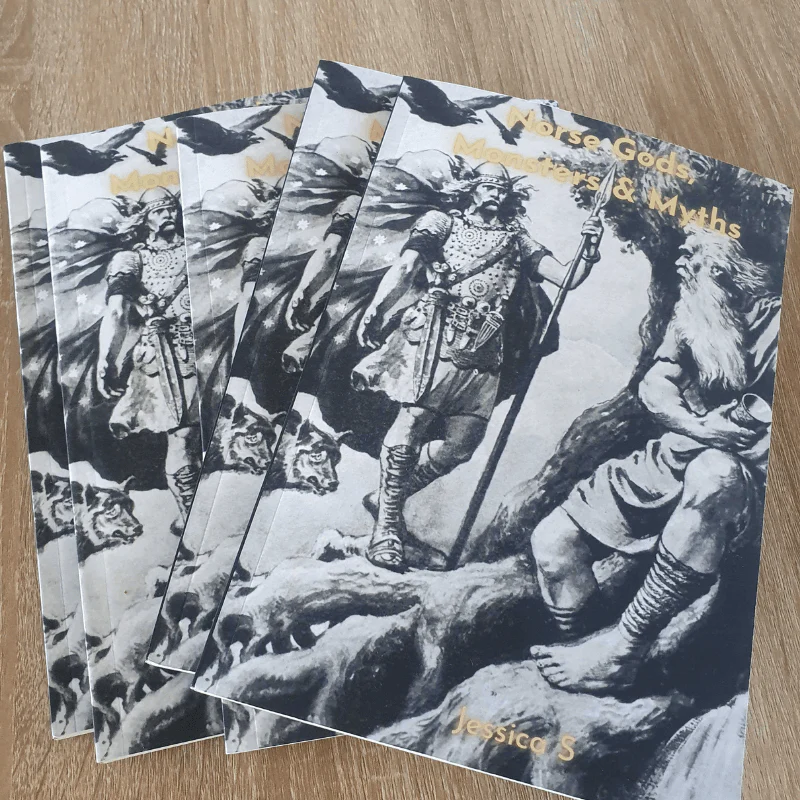
Get Your FREE e-Book
Norse Gods, Monsters & Myths
Read more interesting Viking jewelry reviews!


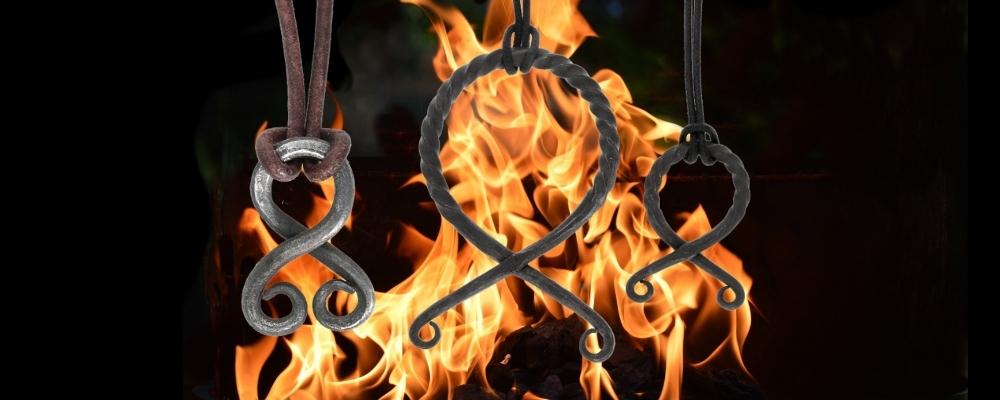



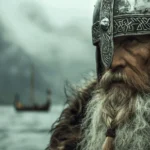
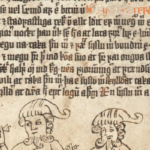

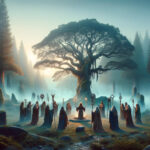
Thanks I would like to read any other printings you have on the Norse myths and folklore
Bravo pour le travail, on voit qu’il y a un ou des passionnés derrière et très bien fait pour quelqu’un de novice intéressé par ce sujet…..
Merci ! 🙂
Leyendo el significado que le dan a muchos de sus símbolos o guías pienso que bajo sus nombres y propias creencias pudieron ser gnósticos como eyggdrasill era el árbol de la vida y sus nueve mundos es igual a la divina comedia que se entiende perfecto en el libro si hay cielo y infierno detalla cada parte de los nueve mundos que para nosotros serian escaleras o pruebas para avanzar. Con diferentes palabras y significados para el momento la serpiente en el árbol lo dice todo
Y lo de Telaraña de Wyrd es para nosotros nuestra única forma de vida
gracias por esta informacion me encanto
Tell me you have no knowledge about the Norse without telling me. The Vegvisir is NOT a Viking symbol. It’s earliest appearance was in the Huld manuscript, which was recorded hundreds of years after the end of the Viking age and the original Norse religion died out. So The Norse never used it.
Thanks for the feedback. While I can see that the original author did say that the Vegvisir came from the Icelandic grimoires and that there is no evidence that it was used in Viking times, I can see how the article is a bit misleading. I’ll update it to make it clearer.
Please, please … I love the vegvisir but it is an Icelandic Norse symbol, sadly there is absolutely no archaeological finds or mention of this that relates it to the viking age. It appears only 600 years after. It uses runes, it is a bind rune but please make it clear it does not relate to the viking age… I thought it was Celt the first time I came across it and I am born and breed with the culture. Same with aegishjalmur. They are both beautiful symbols but till we discover otherwise not from the viking age.
Thank you for an otherwise beautiful text and site.
You make a good point Christina. This article does need rewriting to clear up some issues. I’ll be doing that within the next day or so. Thanks for your thoughtful feedback.